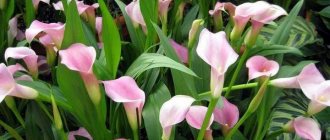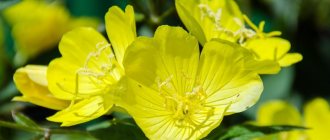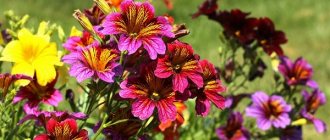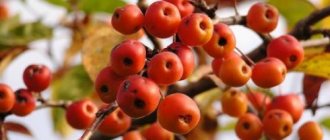Silvery plants: exclusive for your garden!
Many people strive to find and see with their own eyes something original and extraordinary. The reasons for searching can be very different.
For example, if you are given gray flowers, you will be surprised and the person who gave them to you will be pleased. Agree that gray flowers are very rare and look very unusual.
Therefore, to get new and vivid impressions, we try to find something amazing that can evoke positive emotions.
- In our search for the amazing, we encounter interesting materials, people and stories. Thus, we paint our lives in bright colors and expand our horizons.
Unfortunately, we cannot always immediately find what we are looking for, but we won’t talk about that now. We all know well that each garden is unique and differs in its set of flowers and plants, shape, area, and topography.
The garden is a kind of reflection of the gardener who creates it.
Felt lily - magical flowers
The flowers and colors of plants that we choose for our garden can be compared to musical notes, each of which complements each other.
Within the landscape, they are fused into a single whole, flowers and plants are woven together and serve as creative expression.
Therefore, silence and sound in a song are equally important to emphasize each other and find a wonderful balance.
Plants with gray leaves act as musical silence, pause and are a smooth transition among bright compositions.
Gray and silver plants mute overly bright flowers and add a special touch to the garden. They are most often used as a buffer zone between zones with intense color or as a smooth transition.
- Using gray plants and flowers separately helps soften the landscape.
The silver tint or gray color of plants appears as a result of adaptation to dry and arid conditions.
In dry climates and poor soil, the gray and silver color of plants intensifies. In conditions of high humidity they lose color intensity.
The undeniable advantage of gray plants is the ease of care and high vitality of gray plants and flowers.
In addition to their attractive appearance, they are easy and simple to use when creating or modifying your garden.
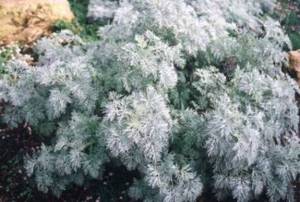
Wormwood Schmidt
The color of a noble metal. Decorate your garden with silver foliage plants
This Mediterranean shrub is usually grown as a backdrop for colorful flowers. Let us consider in detail the topic of growing silver cineraria or, as it is also called, seaside cineraria.
Sowing Cineraria silver seeds
Silver cineraria will not cause any trouble if you plan to try growing from seeds. They can be purchased at almost any store; the seeds are distinguished by their ability to germinate well and quickly. The best time to sow cineraria seedlings is March, but it is not too late to do this in April or even May.
There are several ways to plant cineraria seeds - all of them guarantee a decent result:
- You can sow cineraria in moist soil, but you don’t need to bury the seeds, just crush them a little and cover them with film.
- Another way is to also sow the seeds in a container with moist soil, then sprinkle them with sand and cover them with glass or film.
- Finally, cineraria seeds sown on the surface layer of soil can simply be covered with a layer of thin paper, which, when wet, will allow the seedlings to break through. Again, the container must be covered with insulating material.
In all three cases, covering with film or glass is necessary; such a layer will ensure that the proper level of humidity is maintained. By the way, watering the soil after planting must be done very carefully; a powerful jet can knock down small seeds and disrupt the accuracy of planting. You can spray the soil with a spray bottle, or you can initially select a container with drainage holes and lower it into a stand with water so that the soil is moistened from below.
Seedlings of silver cineraria
In a week or a week and a half after competent manipulations of planting seeds, you can expect the first shoots. Now light is important for the plant, so the flowerpots are moved closer to the windows. The next stage of “growing up” of the plant is the appearance of two leaves on the stem. This is a signal saying that it is time to plant the seedlings in separate pots with peat substrate. Replanting is carried out using the picking method, carefully lifting up a clod of earth along with the roots and placing it in a hole in the new soil. Then the soil around the stem is gently pressed down so that air comes out from under the roots. Do this gently so as not to damage the thin roots.
Cineraria seedlings usually take root well in a new place and by the time they are planted in the ground they have already become stronger. Young plants are planted a month or two after transplantation, that is, in May-June, when the weather becomes warm and there is no longer any risk of frost. Silver cineraria grows until late autumn and all this time does not lose its decorative appearance.
Cineraria care
Both planting and caring for silver cineraria do not require excessive effort. Cineraria grows well in sunny areas, and feels good in partial shade, but at the same time it may partially lose its visual appeal. Periodic fertilizing will promote the development of the plant - it is enough to use fertilizers with a low nitrogen content once or twice a month. It is advisable to provide regular and abundant watering, but in case of drought, the plant is able to support itself for a long time due to its deep root system. Withering and yellowing leaves will immediately indicate diseases of silver cineraria; this bush is rarely affected by pests.
Gray plants and flowers: the most beautiful for your garden!
Perennial
- Chistets Byzantine (lat. Stachys byzantina). People often call it “rabbit ears.” A small plant with a unique silvery sheen on the leaves. Blooms for a long time, throughout the summer. Height is about 15-20 cm.
- Gray fescue (lat. Festuca glauca) . An amazing plant with leaves 15 cm high and inflorescences 30 cm high. With proper care and timely pruning, it forms a dense and beautiful carpet. Flowering time is August.
- Alpine sheep (lat. Helictotrichon sempervirens) . Attracts attention with its elegant leaves and spikes that rise above other gray plants. The leaves are about 25-30 cm long, and the inflorescences are 60-70 cm. Flowering time is July-September.
Annuals
- Seaside cineraria (lat.Senecio cineraria) . This is one of the most silvery and gray flowers and plants on the planet. Silver foliage captivates at first sight. It has not entirely decorative inflorescences, small in height, 15-20 cm.
- Mealy sage (lat.Salvia farinacea Silber) . A favorite variety of many experienced gardeners for its high decorative qualities and unpretentiousness. It blooms intensely and beautifully for a long period of time (June-October). From 30 to 50 cm in height.
- Hairy dry grass (lat. Gnafalium obtusifolium) . Many people successfully grow it on balconies. Long and beautiful shoots overshadow the appearance of the inflorescences. Height – 8-12 cm.
- Schmidt's Wormwood (Artemisia schmidtiana Nana) and Tomentosa are worthy of special mention.
Ornamental grasses (photos and names)
Today there are many types of different plants, each of which differs in growth conditions, appearance and care. Which one to choose is up to each summer resident to decide. The most popular and spectacular ornamental grasses will definitely deserve your attention:
- Blue fescue. A cereal that is small, elongated, hemispherical hummocks of a blue hue. This plant is sold in all specialized stores, so there should be no problems finding planting material. Fescue will decorate your pond, rock garden or flower bed. You can sow seeds both in early spring and late autumn. Place several seeds (2-3 pieces) in a hole, fill them well with water and sprinkle with mineral or organic fertilizer. After a few years, the plant will grow greatly, so there will be a need to divide it. How to care for fescue? Regular watering, fertilization and weed control are sufficient.
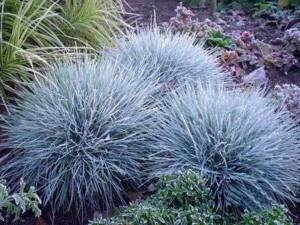
Blue fescue
- Pogonatherium. Are you surprised that this plant can be planted outdoors? Some gardeners really plant it only at home, but in fact, pogonatherium is also allowed to be grown in open ground. The only condition is that for the winter it needs to be brought to a warmer place or heavily covered with additional materials. The grass is very similar to bamboo, only in miniature. It will be an excellent addition to your site and its decoration.
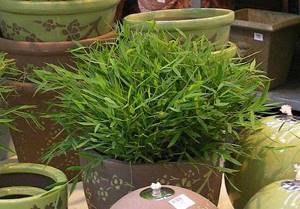
Pogonatherium
- Italian setaria. In some regions of our country, some people grow setaria as bait for livestock, but in reality this plant is very decorative, it has elegance, beauty and bright color, so it will naturally decorate your summer cottage. Setaria grows as shrubs and can reach a height of more than one meter. She loves warmth, high humidity and plenty of sunlight. The optimal temperature for growing it is +25 degrees.
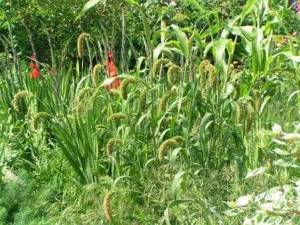
Italian setaria
- Maned barley. The name “maned” was not given by chance. The plant seems to be playing with its dark burgundy spikelets, decorating the area, making it bright and lively. Although maned barley is recognized as a perennial, it is often planted as an annual due to fear of cold weather. The ears reach a height of more than 1 meter and will look very impressive in a flower bed. The plant needs good, fertile soil, regular watering and high-quality fertilizers. It can be planted both in spring and autumn. In winter, the grains do not freeze, but rather become stronger and healthier, so in the spring you will get beautiful maned barley that will decorate your territory.
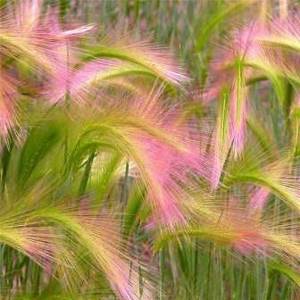
Maned barley
- Cortaderia. A bright, iridescent herb that blooms in lush white inflorescences. Depending on the species, it can be short or tall.
Main types of flower beds
Flower beds come in different types. Depending on the type, they are decorated differently, different plants are used and methods of planting them. This division is conditional; a rectangular elongated flower bed can be called a ridge, a mixborder, a flower bed, and if stones are also placed there, then a rock garden. The name rather depends on how the plants are planted: in even rows, geometric patterns or picturesque groups.
A border is a narrow, elongated flower bed of low-growing plants. As a rule, borders are planted along paths, at the foot of the retaining wall of a terraced garden, and are used to border flower beds, where any border needs to be emphasized. The border should be different in color, but not too prominent. More often, plants of one or two species are used, flowering or decorative foliage. Plants for borders: lobularia, sedum, silver cineraria, heuchera, hosta, holly lavender, silver carpet, mantle, perennial aster.
A flower bed is the most common bright flower garden of regular geometric shape with an intricate pattern. They are used in a regular garden and placed on the site so that it is clearly visible from all sides. Annuals, biennials and bulbous plants with contrasting colors of flowers and foliage are commonly used. As a rule, flowers are planted symmetrically: in rows, circles, complex patterns, sectors. Often the middle of the flowerbed is made higher, and the edges are level with the lawn or paving. Popular plants for flower beds: pansies, tulips, salvias, gaillardias, marigolds, perennial carnations, antirrinums, lobelias, ageratum, antirrinum, silver cineraria, heuchera.
Mixborder (mixed border) is a modified border, the characteristic feature of which is that the plants are not planted in an even row. They are placed in picturesque groups, spots or individually. This type of flower garden is usually used in landscape garden planning.
A mixborder is made up of plants that bloom at different times of the year. It should remain decorative throughout the growing season. It may include annuals and perennials, shrubs, low-growing trees, various types of conifers, and ornamental grasses. Thanks to the inclusion of a large variety of plants, the flowering season in a mixborder lasts from early spring to late autumn.
Rabatka is a flat flower bed in the form of a long strip of different flowering plants, usually located along paths and buildings. The width of the ridge is from 40-50 to half a meter, the length can be any.



